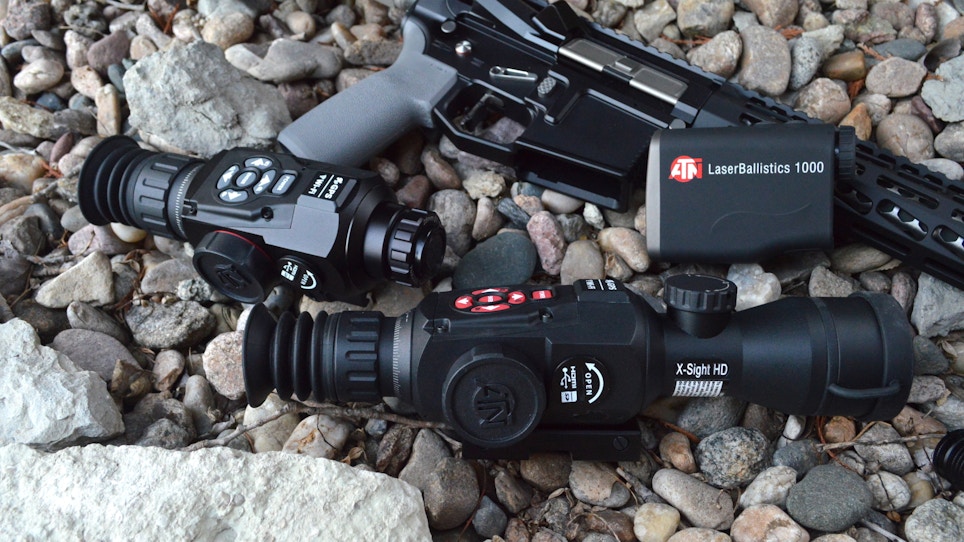Without question, the optics market is changing. Twenty years ago, with the exception of Soviet surplus night vision, electrically powered optics were still considered expensive, highly specialized equipment for the elite military units. Today, every major optics manufacturer offers some type of electro-optics model, and each year we see the sophistication of these digitally powered optics expand. Tactical Retailer had an opportunity to speak with Steve Lemenov, Director of Marketing for American Technologies Network (ATN), to better understand its offerings and where this market is headed.
TR — How would you break down the electro-optic market for a retailer?
Lemenov — The category is broad, covering everything from laser rangefinders, illuminated optics, red dots, holographic and reflex sights and integrated rangefinding scopes to pure digital thermal and night vision optics.
Our focus is on the pure digital smart optics category, which has a specialized lens set delivering image information to a special core processor, and the user views the image on a tiny screen inside the optic. In this digital optics category there are i2, also known as night vision, thermal night vision and smart optics. The smart optics usually combine night vision or thermal night vision with the ability to deliver a standard daylight full color sight with a lot of features to enhance the use, such as video capture and smartphone integration.
TR — Are all night vision and thermal optics pretty much the same?
Lemenov — Back in the Vietnam era, Cold War years and ate 1980s, most of the Gen 1 technology on the market was pretty similar and even through the development of Gen 2 night vision and thermal cores in the late 1980s. After the new Gen 3 cores were developed, the market really started to change and evolve with a lot of differences with everyone developing their own support technologies such as processors, firmware, video display and chassis.
FLIR was the notable leader in thermal and night vision sensor core technology until Gen 4, at which point ATN developed its own Gen 4 cores, which were combined with our own smart firmware and processors. The core is often focused on as the most critical component. However, great attention to all the other components must be assured to get the maximum out of even the best cores.
TR — What are the differences between top-end military night and thermal optics versus a sub $3,000 optic?
Lemenov — Everyone has a lens, core, processors, viewer and firmware. The difference usually comes down to the size of the lens that drives image quality, and the quality of all the other components. We use many of the same components from our top end line all the way down to our Smart optics just to reduce overall manufacturing complexity and total number of inventoried parts such as buttons, chassis and operating systems. Industry-wide this is a very common practice and we are seeing the huge performance gap between the value priced models and top military spec closing.
From a quality of image perspective, variables include field of view width, functional range, image resolution and processor power. The top-end military-grade thermal and night vision optics feature a wider field of view thanks to a large germanium lens with higher resolution that can also deliver a smoother video image. A more consumer-priced model may just have a narrower field of view and just a bit less range and image sensitivity, but can drop the $6,000 price of a top-end thermal to less than $2,700 just due to a much smaller germanium lens.
The bottom line is that the elite military units are buying the absolute best-tuned night vision and thermal equipment money can buy with higher speed processors. For the most part, the consumer market really is not going to pay two times more for what would typically be viewed as a smaller incremental improvement just to shoot invasive predators — but if that predator is shooting back, it is worth buying into the extra sensitivity.
TR — Are the Germanium lenses the most expensive components?
Lemenov — Yes. They are a required component for both our premium thermal and night vision electro-optics and definitely influence the price the most due to availability and the cost. Germanium is a very rare, expensive element required for the lens — the larger the germanium lens is for our thermal or night vision the better the image quality, but the cost goes up exponentially.
TR — Are most of ATN’s sales to military and law enforcement?
Lemenov — Actually 70 percent of our sales are to the civilian markets. The predator hunting market has been a huge driver of thermal and night vision optics. For the price of a high-quality standard optic, a hunter can have a smart thermal optic that allows them to scan hundreds of acres of land at night quickly to maximize a hunt and predator reduction. Our smart night vision and digital-enabled rangefinders have been huge hits.
The X-Sight smart optic technology drove the price of our thermal and night vision optics price down even more. A lot of sales were thanks to the many YouTube hog hunting guides showing amazing results with thermal and night vision optics, noting 20 to 30 hogs shot per night. At this point, most people feel that a hog hunt is crippled without some type of night vision or thermal optics.
TR — Can you give dealers a brief history of ATN?
Lemenov — ATN has been around for about 20 years, since 1995, and started as a Silicon Valley startup operation initially selling Russian surplus night vision optics. Even those old Gen 1 technologies that used night vision optics were easily $1,000 or more, but still worked well despite grainy images, limited range and narrow fields of view. Those units introduced the U.S. hunting market to affordable military night vision optics and started the consumer market we see today.
Over the years, we started to develop our own technology and electro-optics sights as night vision and thermal optic cores became available in the market. We then pushed into Smart optics and shifted from a surplus remarketer to being recognized as a top tier thermal and night vision manufacturer.
Through the Desert Storm, Iraq and Afghanistan wars, we sold approximately 60,000 night vision goggles to various U.S. and other allied militaries. After 9/11, the domestic law enforcement market starting to regularly leverage our optics as well.
Around 2010, we introduced the THOR thermal optic with a $15,000 retail price and were shocked to see it selling to consumers. We know if we could get the price down we could really drive a lot of customers to the technology. Our 2nd Gen Thermal technology featured new FLIR cores, smaller, lighter, tougher more durable optic models.
Though the external durability was quite good, the old night vision systems from everyone had a lot of problems including overexposure, low battery damage to systems, poor battery life, difficult configuration and a complete lack of features. The ATN X-Sight Smart Optics models really changed everything for us in 2014, and also changed the market. Each year, we have been able to offer market leading prices while increasing quality and features.
TR — Has the ATN Smart Optics line been popular?
Lemenov — They have. We transitioned in 2014 to the X-sight “Smart” thermal scopes all featuring our own cores. Customers could now buy an ATN HD Thermal optic for around $2,000 and our HD day/night vision X-Sight optic for around $599. The technology we developed in the Smart HD line now represents 90 percent of our sales.
The X-Sight represents a huge degree of refinement over the old style systems with high-def imaging, free online firmware updates/upgrades and bug fixes, video and image capture, Wi-Fi connectivity, iPad/Android integration, ballistics calculator, simple configuration and zeroing and many more features. We introduced our Gen 2 HD X-Sight, which is again a huge jump over the previous Gen 1 X-Sight.
TR — How do dealers sell your products?
Lemenov — We wanted to keep things easy for the dealer and are primarily a distributor-driven product line with distribution in almost every major firearms distributor. Dealers can add on an ATN product to their regular distributor order and still expect margins similar to other optics and electro optics manufacturers with no minimums required.
Our marketing strategies include print, online, social media, third party media and distributor marketing programs. We also offer various rebates and are committed to keeping the brand name out there to pull through sales for the dealer.
TR — Which should a dealer recommend to a customer — thermal or night vision optics?
Lemenov — Thermal is good for search and rescue and where there are wide temperature differences between a living object and the background. Of note, thermal does not work behind glass, inside a car or looking into/through a building. For the hunting segment, thermal is growing faster.
Night vision is still very relevant and available at a lower retail price and has the advantage of delivering visual details that can differentiate between people. LEO use night vision the most because they have to be able to distinguish who is who. Thermal would just show there are two indistinguishable individuals.
TR — In 10 years, will we still have traditional glass optics?
Lemenov — There will always be customers who want traditional glass optics. As the younger generation grows up in the digital world, these younger shooters who have grown up with the iPads and internet in a purely digital age expect optics to deliver advanced features beyond just an illuminated BDC reticle.







